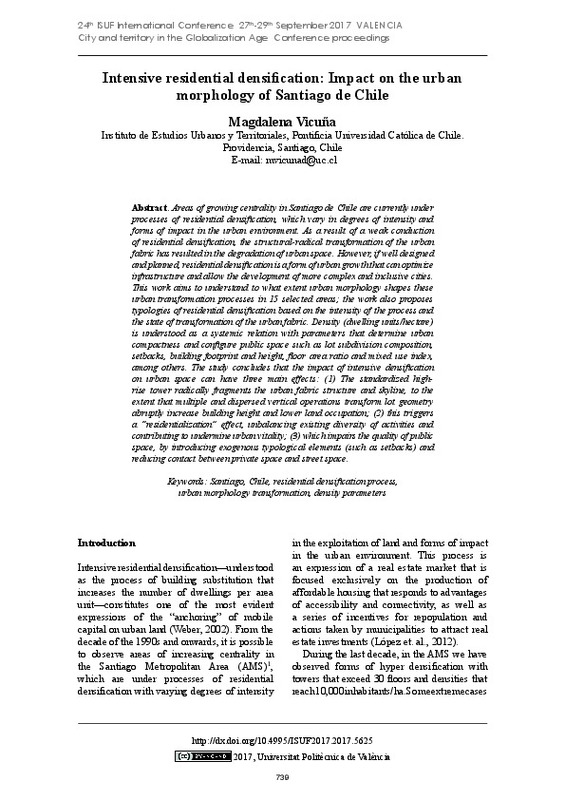JavaScript is disabled for your browser. Some features of this site may not work without it.
Buscar en RiuNet
Listar
Mi cuenta
Estadísticas
Ayuda RiuNet
Admin. UPV
Intensive residential densification: impact on the urban morphology of Santiago de Chile
Mostrar el registro sencillo del ítem
Ficheros en el ítem
| dc.contributor.author | Vicuña, Magdalena
|
es_ES |
| dc.coverage.spatial | east=-70.6692655; north=-33.4488897; name=Santiago, Región Metropolitana, Xile | es_ES |
| dc.date.accessioned | 2018-12-17T09:18:15Z | |
| dc.date.available | 2018-12-17T09:18:15Z | |
| dc.date.issued | 2018-04-20 | |
| dc.identifier.isbn | 9788490485743 | |
| dc.identifier.uri | http://hdl.handle.net/10251/113898 | |
| dc.description.abstract | [EN] Areas of growing centrality in Santiago de Chile are currently under processes of residential densifica/ion, which vary in degrees of intensity and forms of impact in the urban environment. As a result of a weak conduction of residential densification, the structural-radica/ transformation of the urban fabric has resulted in the degradation of urban space. However, if well designed and planned, residential densification is aform of urban growth that can optimize infrastructure and allow the development of more complex and inclusive cities. This work aims to understand to what extent urban morphology shapes these urban transformation processes in 15 selected areas; the work also propases typologies of residential densification based on the intensity of the process and the state of transformation of the urban fabric. Density ( dwelling units/hectare) is understood as a systemic relation with parameters that determine urban compactness and corifigure public space such as lot subdivision composition, setbacks, building footprint and height, floor area ratio and mbced use index, among others. The study concludes that the impact of intensive densification on urban space can have three main effects: (1) The standardized highrise tower radically fragments the urban fabric structure and skyline, to the extent that mu/tiple and dispersed vertical operations transform lot geometry abruptly increase building height and lower land occupation; (2) this triggers a "residentialization " effect, unbalancing existing diversity of activities and contributing to undermine urban vitality; (3) which impairs the qua/ity of public space, by introducing exogenous typological elements (such as setbaclrs) and reducing contact between private space and street space. | es_ES |
| dc.format.extent | 10 | es_ES |
| dc.language | Inglés | es_ES |
| dc.publisher | Editorial Universitat Politècnica de València | es_ES |
| dc.relation.ispartof | 24th ISUF International Conference. Book of Papers | es_ES |
| dc.rights | Reconocimiento - No comercial - Sin obra derivada (by-nc-nd) | es_ES |
| dc.subject | Santiago de Chile | es_ES |
| dc.subject | Residential densificationn process | es_ES |
| dc.subject | Urban morphology transformation | es_ES |
| dc.subject | Density parameters | es_ES |
| dc.title | Intensive residential densification: impact on the urban morphology of Santiago de Chile | es_ES |
| dc.type | Capítulo de libro | es_ES |
| dc.type | Comunicación en congreso | es_ES |
| dc.identifier.doi | 10.4995/ISUF2017.2017.5625 | |
| dc.rights.accessRights | Abierto | es_ES |
| dc.description.bibliographicCitation | Vicuña, M. (2018). Intensive residential densification: impact on the urban morphology of Santiago de Chile. En 24th ISUF International Conference. Book of Papers. Editorial Universitat Politècnica de València. 739-748. https://doi.org/10.4995/ISUF2017.2017.5625 | es_ES |
| dc.description.accrualMethod | OCS | es_ES |
| dc.relation.conferencename | 24th ISUF 2017 - City and Territory in the Globalization Age | es_ES |
| dc.relation.conferencedate | Septiembre 27-29,2017 | es_ES |
| dc.relation.conferenceplace | Valencia, Spain | es_ES |
| dc.relation.publisherversion | http://ocs.editorial.upv.es/index.php/ISUF/ISUF2017/paper/view/5625 | es_ES |
| dc.description.upvformatpinicio | 739 | es_ES |
| dc.description.upvformatpfin | 748 | es_ES |
| dc.type.version | info:eu-repo/semantics/publishedVersion | es_ES |
| dc.relation.pasarela | OCS\5625 | es_ES |








